Postcards from Kyoto - Misuyabari and Hakotou, for lovers of sewing and handcrafts
I am afraid that this edition of Postcards from Kyoto has no food in it, but I hope you will bear with me. I don't really consider myself to be a very domestic person - I hate cleaning, and doing the dishes, and stuff like that - but I do like cooking (obviously) and I like handcrafts and sewing. Well, at least I admire sewing and such -- I rarely seem to find the time to do much sewing and embroidery and things myself. I suppose that I could cut down on the time spent playing games on my iPhone...
Anyway, when I was in Japan, I had to mend a huge tear in the lining of my coat. I started out using a portable sewing kit I had with me. My mother saw me muttering and swearing, pushing and tugging at the needle to get it through the densely woven fabric of the coat.
"Here, try this" she said, handing me a long, plain steel needle. Unlike most needles sold these days, it had no gold on it. I looked at it disdainfully, asking "How can a needle make that much of a difference?" But I switched over from the one I was using anyway, to make my mom happy.
What a difference! This needle passed through the difficult fabric without any resistance, even through several layers. It was actually a pleasure to complete the boring mending task. Who knew that a needle could make such a difference! I knew right away that I had to get some of these wonderful needles for myself.
It turns out that the needle is indeed special. It's made by a 360+ year old company that has been owned by the same family in Kyoto, called Misuyabari (Japanese only web site) - or to give its full name, Sanjo-Honke Misuyabari (三條本家 みすや針). Bari or hari means 'needle' in Japanese.
Finding the Misuyabari store is a bit tricky. To the north and east of Nishiki Market, on Sanjo Dori (三条通り) between Teramachi Dori and Kawaramachi Dori, there is a rather touristy, even slightly tacky, covered mall or sho-tengai.
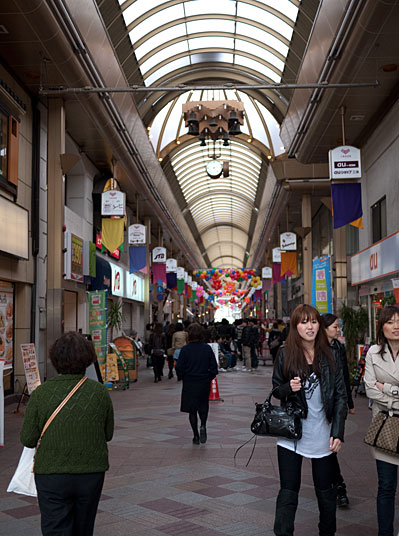
On the north side of the mall, past a very ordinary clothes boutique, there's a fortune teller. There is a sign for Misuyabari, which is in Japanese only...it looks like this:
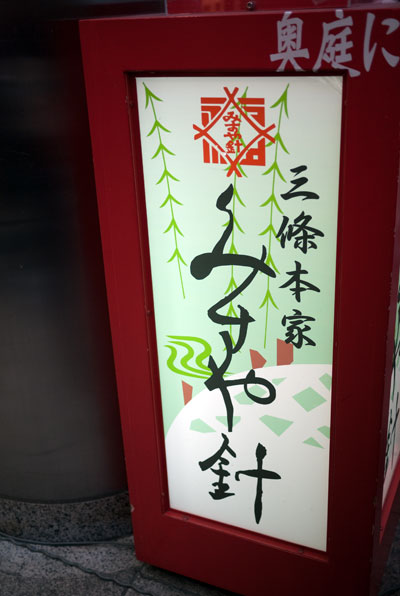
In between the clothes shop and the fortune teller, marked at the entrance by that sign, is a narrow alleyway. Go down that alleyway (the sign on the right there is for the fortune teller)....
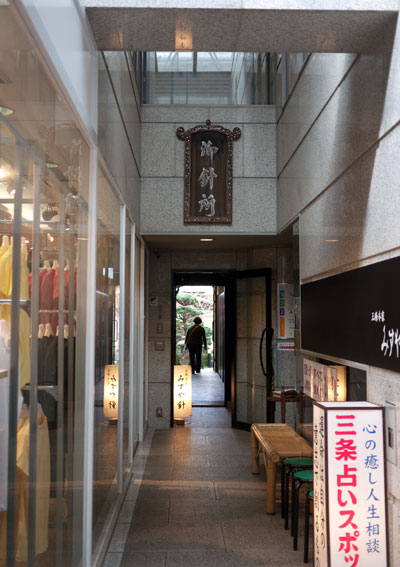
And hidden back there is another world - a tiny, jewel-like traditional Japanese garden, with a small store tucked away in the back. That is Misuyabari.
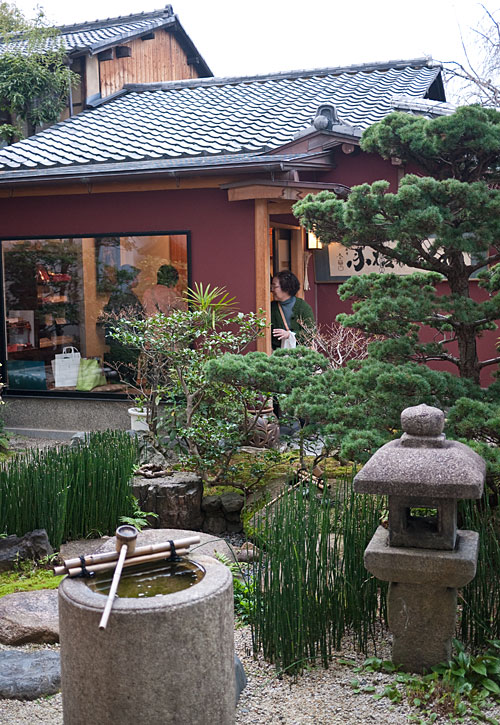
The store is really small - just a counter, manned by the owner or his wife, a few shelves on the side, and a little bench. But it's a place to make any sewer or craft person's heart beat faster. There are, of course, many, many needles, lovingly displayed in a glass case. The Misuyabari needles are still made one by one. They are a bit flexible, very sharp, and the points are bent at an angle that is so infinitesimal that it cannot be seen by the naked eye. The eye of each needle is round, as opposed to the elongated oval of ordinary needles, so that they can be threaded easily. In other words, each needle is crafted like a miniature knife.
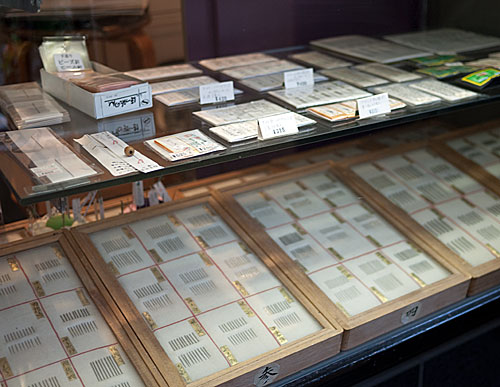
Misuyabari used to supply needles to the imperial court -- a serious task indeed, given the amount of fine sewing that must have been done there. Needles also used to be considered an ideal gift from Kyoto for travelers who made the trip from Edo (old Tokyo) on the Tokaido road, since they weighed next to nothing. In the olden days, needles were sold by weight, weighed by a specialized scale. This scale has been in the family for generations. The current owner said he is the 18th head of the company. (My mother begged him to sell the scale to her, but he gently refused.)
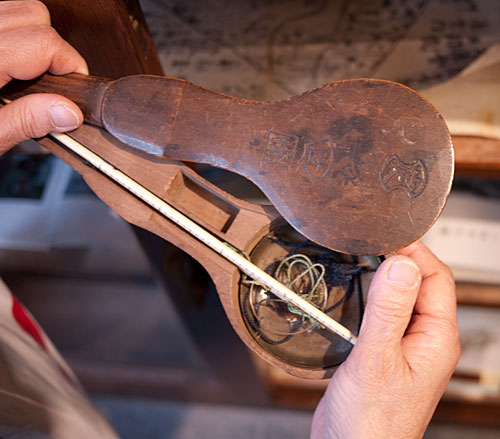
Other beautiful sewing related items are available too, like these sewing boxes made of kiri or paulownia wood. Kiri wood boxes and furniture are highly prized in Japan. Kiri wood is said to be ideal for sewing boxes, since they can be closed quite tightly and keep needles from rusting.
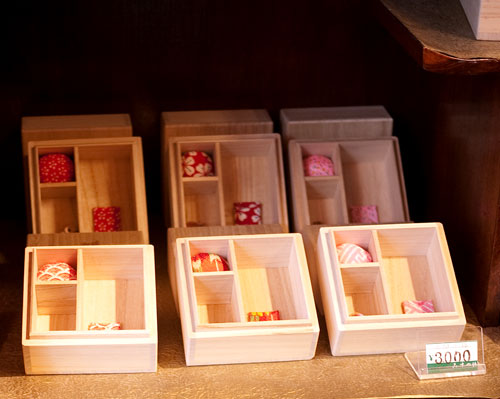
Also available were some colorful celluloid boxes. Celluloid is having a bit of a revival these days in Japan, due to Showa era (the reign of Emperor Hirohito as he's known outside of Japan, from the '40s to '80s) nostalgia or "Showa Retro" (昭和レトロ). Every Japanese girl growing up during the early Showa era had a little celluloid sewing box, carried to school for sewing or home economics classes. (By my time the celluloid had been replaced with plain old plastic.)
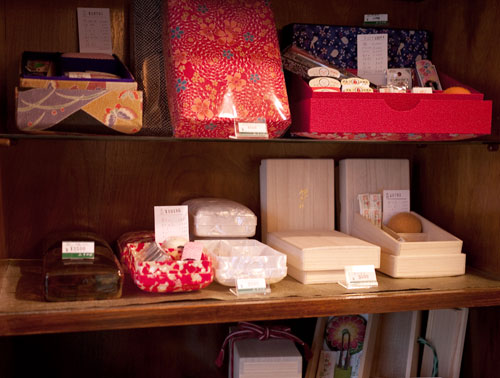
There are pin cushions made from traditional Kyoto fabric (Kyo chirimen) and stuffed with lambswool, tiny portable sewing kids in kiri boxes, and so much more here.
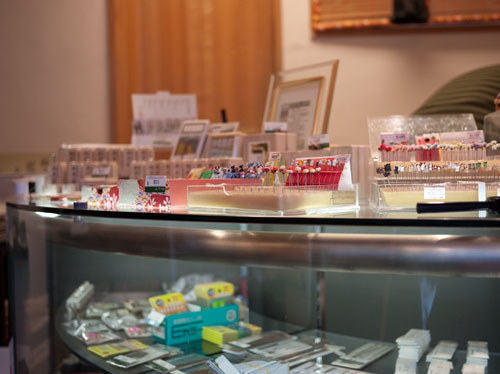
For something quite modern-cute-Japan, I fell in love with these little pins. They are handcrafted one by one, by a single artisan. They are not cheap (nothing in this store is) at 200 to 300 yen each...but so adorable, and each one is unique.
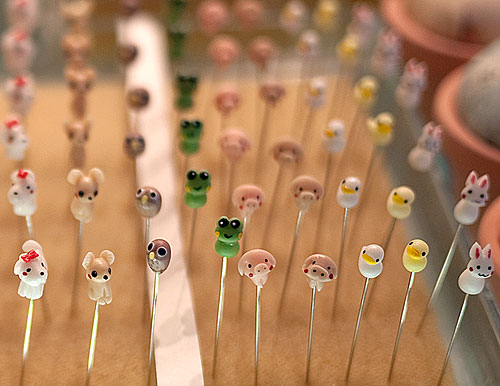
Hakotou: Handpainted kiri boxes
Although I was tempted to buy a kiri wood sewing box at Misuyabari, my heart was set on a sewing box from another company, Hakotou Sho-ten(箱藤商店). Compared to Misuyabari, who started supplying needles to the imperial court in 1651, Hakotou is a new upstart - the company started in 1891. Nevertheless, they make the most beautiful, handcrafted and handpainted, kiri or paulownia wood boxes. Their store has a strict no-photo policy, but you can check out their offerings on their web site. Besides their readymade boxes, they also do special orders.
So, this is the sewing box that I got. It is shaped like a tea ceremony box (used to transport the tea cup and such used during the ceremony), with a Sanadahimo woven ribbon or cord for carrying the box when closed. The lid is handpainted with pictures of sewing implements.
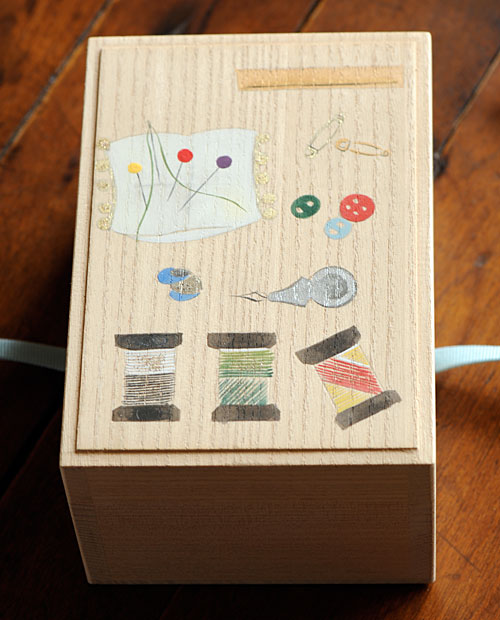
Here's the box open. It has two layers, and the small pincushion made of Kyo Chirimen fabric is included. The dividers are movable.
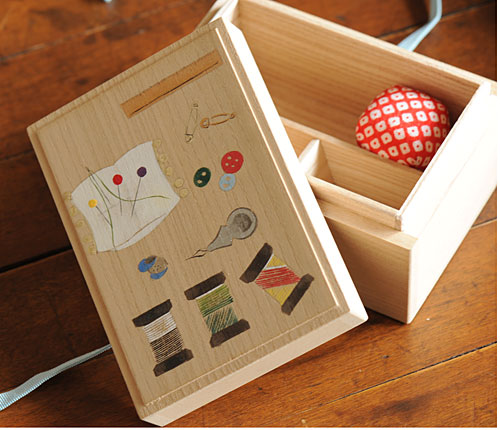
Since the box is handcrafted, the lid fits best a certain way. A little pin is painted on one side of the lid and box, which marks the right way to close the lid.
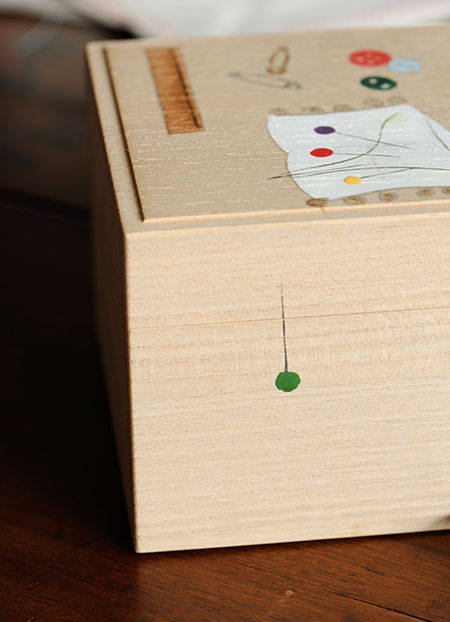
To be honest, the box is so gorgeous that I haven't used it yet! It's sitting in its gift box, and I take it out to admire it and put it back. In the meantime my real sewing stuff is in a big old bag. Such is life...
Practical details
As described above, Misuyabari is located on Sanjo Dori (三条通り) between Teramachi Dori and Kawaramachi Dori, down a narrow alleyway on the north side of Sanjo Dori, behind the main façade of stores. It's open from 10am to 6pm, and is closed on Thursdays. Besides the little store they also have a gallery and cafe on the second floor of the building in front of the store.
〒604-8036
京都市中京区三条通河原町西入ル
TEL: (075) 221-2825
FAX: (075) 252-1818
Japanese only web site. They have a mailorder service (shipping within Japan only).
I do not believe that English is spoken here, but prices are clearly marked. If you are after needles, just state clearly what kind of sewing you need it for, e.g. 'sashiko' They sell machine needles as well as handsewing needles.
Incidentally, there's another company that is also from Kyoto called Misuya Chuubeh (みすや忠兵衛)that also sells needles and sewing supplies. They often appear at Kyoto festivals in department stores, and have stores nationwide. If you've bought a "Misuya Needles" sewing set from a mailorder place, chances are it was from them. I'm not quite sure if there's any connection between Misuya Chuubeh and Misuyabari (which is also. confusingly, called Fukui Misuyabari). I checked out the Misuya Chuubeh stall at a Kyoto festival at a Tokyo department store, they sell (to me) pretty run-of-the-mill sewing supplies, sewing boxes and accessories made from chirimen fabric of various quality, and the like. They also sell needles, but they are rather lost in all the junk on display.
The 'real' Misuyabari, which is a very special store, does not participate in department store festivals, have satellite stores in any department stores and the like. (To be a bit cynical, this relaxed way of doing business is probably because the company actually owns quite a lot of the real estate along that stretch of Sanjo Dori - prime Kyoto real estate in other words. I'm guessing that they make more money from rents and stuff than from their needle business!)
Hakotou Sho-ten's main store is a modern boutique next to the Tokyu Hotel, which is near Nishihongan-ji temple at Horikawa Gojo. Open from 9am to 6am, closed Sundays and holidays and often closed on Saturdays too.
Hakotou also sells their boxes at Takashiyama department store on Shijo Dori - they actually have more boxes on display there than at their boutique. I am not sure if they speak much English (their website is in Japanese only) but you can surely try - and they may have English speaking help at Takashimaya.
〒600-8357
京都市下京区堀川通五条下ル柿本町580-8
TEL: (075)351-0232
FAX: (075)342-4395
Japanese only web site. They have a mailorder and special order service (shipping within Japan only).
As always, please consult my Kyoto Destinations map for locations.
Other Postcards from Kyoto
I am planning to wrap up the Kyoto Postcards series with one, maybe two more posts. I know that they are lacking in the usual Kyoto things like temples and shrines and geiko (geisha) and the like. But you can find plenty of Kyoto trip reports and guides focusing on those things so... (The recent New York Times travel article has an entirely different take on Kyoto from mine.) And I'll get to some Tokyo stuff soon too.
(Update: The series is now complete.)
- Sweet Destinations
- Tofu from bean to plate
- Nishiki Market, Masugata Arcade and the tradtional shoten-gai
- Keibunsha, the monthly market at To-ji, and Conclusion
If you enjoyed this article, please consider becoming my patron via Patreon. ^_^

 Welcome to Just Hungry, where we serve authentic Japanese recipes and more! I'm
Welcome to Just Hungry, where we serve authentic Japanese recipes and more! I'm 














Comments
Jen @ Tiny Urba...
28 April, 2010 - 06:39
Permalink
Re: Postcards from Kyoto - Misuyabari and Hakotou, for ...
What a fantastic post! I love how you give so much history and detail about these two stores. The pins are adorable, and those boxes are beautiful.
Kim
28 April, 2010 - 09:30
Permalink
Re: Postcards from Kyoto - Misuyabari and Hakotou, for ...
I love these posts - you're right, if I need temple info I can open my guidebook. These are more useful :)
Nellig
28 April, 2010 - 09:49
Permalink
Re: Postcards from Kyoto - Misuyabari and Hakotou, for ...
Wow! Hyperventilating now. I have GOT to go there! This is a complete revelation. Exactly the kind of thing that makes your blog so essential.
Thanks for the precise, useful detail. You're amazing.
Mar
28 April, 2010 - 17:46
Permalink
Re: Postcards from Kyoto - Misuyabari and Hakotou, for ...
Thank you so much for all your posts from Kyoto! I'm going there this summer, so I'm really excited to see and try all the things and food you've been posting about.
Peggy R
28 April, 2010 - 21:02
Permalink
Re: Postcards from Kyoto - Misuyabari and Hakotou, for ...
Maki, thanks for the wonderful posts from Japan. I visited Kyoto in November to see the beautiful fall foliage. Stupendous! Traveling solo with no Japanese skills I wandered into many wonderful little shops not really knowing what I'd find inside. I wish I had found this little jewel. Can we find these needles in US stores?
Lexi
28 April, 2010 - 22:02
Permalink
Re: Postcards from Kyoto - Misuyabari and Hakotou, for ...
As an amateur crafter I loved this post - the descriptions are so evocative and the pictures are stunning!
Phyllis
29 April, 2010 - 01:27
Permalink
Re: Postcards from Kyoto - Misuyabari and Hakotou, for ...
I love using Japanese sewing needles for hand sewing, they are **the best** in the world! Right now I use T.E.C needles from Toyoko that I buy from a couture sewing notions web site. How I wish I could use these!
Shari
29 April, 2010 - 08:00
Permalink
Re: Postcards from Kyoto - Misuyabari and Hakotou, for ...
Just wonderful! Thank you for sharing this. It's so great to see all of these places, I love how you give us not only the stores but their history, great photos, and information for finding each place. I never would have even thought of Kyoto for needles, despite my visits and friends who live there. Next time I'm in Kyoto, I'm going to have to stop by these places!
Claudine
29 April, 2010 - 15:32
Permalink
Re: Postcards from Kyoto - Misuyabari and Hakotou, for ...
Thanks for writing this lovely post. It made my whole morning.
Fayet
29 April, 2010 - 18:41
Permalink
Re: Postcards from Kyoto - Misuyabari and Hakotou, for ...
What a pretty store! I never expected that to be hidden behind the covered mall - and of course I didn't find it. I really enjoyed reading your postcards from Kyoto. I just returned a few weeks ago from a three-week-journy through Japan, and I enjoyed it so much that every time now I see or read something about Japan, I get this longing feeling of wanting to go back again. It was beautiful, and forgein, and so very different.
If you're doing more postcards, could you explain the concept of the strawberry-cream-cake to me? It seemed to be everywhere, and I guess it's a rather stylish food to have - at least the cafés were packed and the cake very expensive (even compared to the general expensiveness of food in Japan). But I totally didn't understand why it had to be strawberry. Care to enlighten me?
Thanks again for that great post, and for this awesome homepage in general - the fact that I learned so much about japanese food on here made traveling so much easier. I thanked you in my mind quite often for saving me from food-disasters! ^_^
Judy
3 May, 2010 - 05:12
Permalink
Re: Postcards from Kyoto - Misuyabari and Hakotou, for ...
Is there any way I can get some of the needles here in California? Sharps #10 or thereabouts. I make miniature doll clothing by hand and I get very close to my needles, shall we say. I know a good thing handmade is worth every last cent.
Thanks for the post-you rock!
Aunt LoLo
5 May, 2010 - 14:31
Permalink
Re: Postcards from Kyoto - Misuyabari and Hakotou, for ...
GAK. Oh, seriously - I've never wished I lived in Kyoto more than this moment. How gorgeous!!! Thank you for sharing.
Susie
11 May, 2010 - 11:11
Permalink
Re: Postcards from Kyoto - Misuyabari and Hakotou, for ...
I have been your reader for couple of months now and I am really glad to find some information on Kyoto on your blog. I am planning to visit Kyoto in Autumn and this will come in handy.
Thx for sharing! =)
Alice Darling
16 June, 2010 - 21:24
Permalink
Re: Postcards from Kyoto - Misuyabari and Hakotou, for ...
Those sewing boxes are adorable! I hope I can find a way to purchase one without the trip to Japan, which I'll never be able to work out. I love your pictures and articles.
Beatrice
4 May, 2011 - 18:32
Permalink
Re: Postcards from Kyoto - Misuyabari and Hakotou, for ...
Hello,
a 'foodie' friend mentioned your blog and this post.
Thank you so much! I'm a quilter and walked in that area on my trip to Kyoto 2 years ago. Now I have found a good excuse (I wish) to go back as I, of course, had completely missed this shop!
Beatrice (from France - Europe).
Funaek
30 August, 2011 - 17:55
Permalink
Re: Postcards from Kyoto - Misuyabari and Hakotou, for ...
I love your Kyoto series! With your wonderful pictures and vivid descriptions, I feel like I'm there with you sneaking into a narrow alley and finding this beautiful needle shop. I love these small specialty stores with great craftsmanship!
audible
21 January, 2012 - 09:47
Permalink
Re: Postcards from Kyoto - Misuyabari and Hakotou, for ...
I found the shop thanks to your map. I passed by it a few times. It's easier to see the shop's sign walking out of the shopping street, heading towards Sanjo station, on the left.
If you've come from Sanjo station, look to your right. Watch for the tiny opening in the buildings. Look past the granite hallway and you can see the wooden hall and garden beyond.
They don't speak much English, but if you you look like me (not Japanese) they'll try to use the cheat sheet behind the counter to help you find the kind of needles you're looking for. The prices are very reasonable- 25 needles for 420 yen. The sewing boxes are cute, around 3,000 yen. They also have some nice Japanese sheers for quickly snipping thread.
Totally made my afternoon in Kyoto. Thanks again.
Lesley Gooda
29 March, 2012 - 10:45
Permalink
Re: Postcards from Kyoto - Misuyabari and Hakotou, for ...
Just discovered your Postcards from Kyoto site - and it's ended! that's a real bummer!!
viviane
26 April, 2013 - 16:52
Permalink
Re: Postcards from Kyoto - Misuyabari and Hakotou, for ...
Thank to your fantastic post and your very clear explanations I had the pleasure to discover this wonderful little shop during my stay in Kyoto last week. I bought some precious needles and a small sewing wooden box (as birthday present for my daughter). To be sure to find the shop I had printed the pictures in your post and your explanations. Great !
I love Japan and it was my third visit to Kyoto.
Thank you again.
Viviane (from France)
Igor
26 May, 2013 - 03:28
Permalink
Re: Postcards from Kyoto - Misuyabari and Hakotou, for ...
I am writing to request your permission to use two of your photographs shown in this article on Misuya Bari. I was there and took several good pictures of the garden, but I did not visit the store. I have written an article about Kyoto Machiyas and I plan to include my pictures of the garden. However, I would like to also include a couple of images of goods sold in the store. The two images are misuyabari5.jpg and misuyabarimachibari-s.jpg.
Of course, I will credit the source (and link to this website), as required.
Thanks, so much.
Igor I. Solar
Digital Journalist
Sarah Turnbull
27 February, 2014 - 12:02
Permalink
Re: Postcards from Kyoto - Misuyabari and Hakotou, for ...
Just wanted to add that there is English assistance available at Takashimaya. Just go to the information desk at the main entrance. There are always English-speaking staff on hand and they will be able to help you find the Hakatou boxes (assuming Takashimaya still stocks them - I haven't checked this).
Sarah T
19 March, 2014 - 14:30
Permalink
Re: Postcards from Kyoto - Misuyabari and Hakotou, for ...
Yippee, I found Misuyabari thanks to your excellent photos!
Just wanted to add that if you walk along Teramachi, you'll eventually come to an intersection where there's a restaurant with a huge crab on the front of it. Stand facing the crab, then turn right into Sanjo Dori (another covered street). Walk along slowly, watching out on your left for the sign shown in the photo and the garden beyond it.
By the way, on top of the sign is a cute display in a case - a little scene with dolls and pins from the shop.
I had a lovely time chatting to the two gentlemen in the shop in my somewhat broken Japanese. They patiently explained everything to me and threw in the occasional technical word in English. The younger man explained that he was the 18th generation in the family business!
I picked up sashiko needles for my sewing guild, a tekobari for a special request, cross stitch needles and thread snips as a souvenir for a friend, and dressmaking pins for me. I'm an Aussie and the current exchange rate made it reasonable. However I think the needles are inexpensive even for Japanese people, considering the quality.
Finally, just wanted to add a note that the needles of course come in different lengths - so if you are buying for friends make sure to find out. I should have asked my sewing guild for their preferences. Anyway, I took one of the middle sizes, which the man in the shop advised was the most popular.
Maki-san, ありがとう ございます!
Sarah T
19 March, 2014 - 14:39
Permalink
Re: Postcards from Kyoto - Misuyabari and Hakotou, for ...
Oh, forgot to add that the Kyoto Fureaikan (crafts museum) shop has a small selection of Misuyabari needles. Handy for those who can't get to the Misuyabari shop. Not sure how much English the staff in the shop speak, but some of the curatorial staff in the museum speak English and might be able to help you.
The Fureaikan is in the basement of a larger building called Miyako Messe, close to Heian Shrine. It's well worth a look, or you can just pop into the shop if time is short. Entry is free.
Search for 'kyoto fureaikan' for more details.
Terri
20 January, 2015 - 09:15
Permalink
Re: Postcards from Kyoto - Misuyabari and Hakotou, for ...
Thanks for your article, have just got back after buying a few supplies.
I caught a bus from Kyoto station [Stand A2 can catch bus 4, 17 or 205] got off at kawaramachi sanjo stop walked back to a shopping mall about 50m I think then it was not far from the corner on the right, about 20m, still down between the clothes shop and the fortune teller. Im happy onto the Tokyo quilt show next.